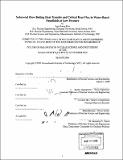Subcooled flow boiling heat transfer and critical heat flux in water-based nanofluids at low pressure
Author(s)
Kim, Sung Joong, Ph. D. Massachusetts Institute of Technology
DownloadFull printable version (53.69Mb)
Other Contributors
Massachusetts Institute of Technology. Dept. of Nuclear Science and Engineering.
Advisor
Jacopo Buongiorno and Lin-wen Hu.
Terms of use
Metadata
Show full item recordAbstract
A nanofluid is a colloidal suspension of nano-scale particles in water, or other base fluids. Previous pool boiling studies have shown that nanofluids can improve the critical heat flux (CHF) by as much as 200%. In this study, subcooled flow boiling heat transfer and CHF experiments were performed with low concentrations of alumina, zinc oxide, and diamond nanoparticles in water (< 0.1 % by volume) at atmospheric pressure. It was found that for comparable test conditions the values of the nanofluid and water heat transfer coefficient (HTC) are similar (within ±20%). The HTC increased with mass flux and heat flux for water and nanofluids alike, as expected in flow boiling. The CHF tests were conducted at 0.1 MPa and at three different mass fluxes (1500, 2000, 2500 kg/m2s) under subcooled conditions. The maximum CHF enhancement was 53%, 53% and 38% for alumina, zinc oxide and diamond, respectively, always obtained at the highest mass flux. The measurement uncertainty of the CHF was less than 6.2%. A post-mortem analysis of the boiling surface reveals that its morphology is altered by deposition of the particles during nanofluids boiling. A confocal-microscopy-based examination of the test section revealed nanoparticles deposition not only changes the number of micro-cavities on the surface, but also the surface wettability. A simple model was used to estimate the ensuing nucleation site density changes, but no definitive correlation between the nucleation site density and the heat transfer coefficient data could be found. (cont.) Wettability of the surface was substantially increased for heater coupons boiled in alumina and zinc oxide nanofluids, and such wettability increase seems to correlate reasonably well with the observed marked CHF enhancement for the respective nanofluids. Interpretation of the experimental data was conducted in light of the governing surface parameters and existing models. It was found that no single parameter could explain the observed HTC or CHF phenomena. The existing models were limited in studying the surface effects, suggesting that more accurate models incorporating surface effects need to be developed. Finally, the research activities performed in this thesis help identify the research gaps and indicate future research directions.
Description
Thesis (Ph. D.)--Massachusetts Institute of Technology, Dept. of Nuclear Science and Engineering, 2009. Cataloged from PDF version of thesis. Includes bibliographical references (p. 285-290).
Date issued
2009Department
Massachusetts Institute of Technology. Department of Nuclear Science and EngineeringPublisher
Massachusetts Institute of Technology
Keywords
Nuclear Science and Engineering.